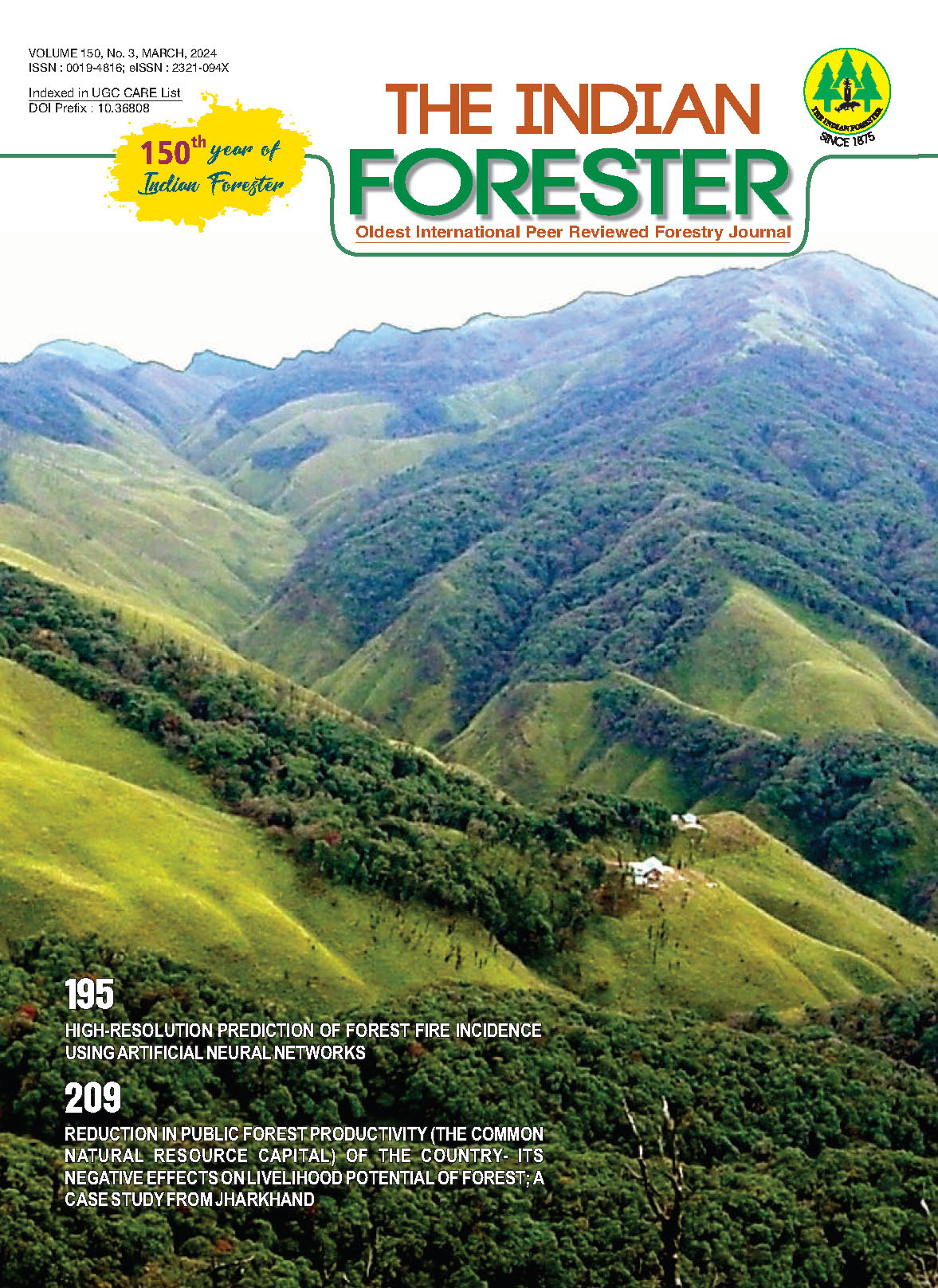Assessment of Morphological Variability in Gum karaya (Sterculia urens Roxb.) from Tropical Deciduous Forest of Madhya Pradesh
DOI:
https://doi.org/10.36808/if/2024/v150i3/170145Keywords:
Gum Karaya, Variability, Morphology, Conservation, NTFP, Endangered.Abstract
The study presents a comprehensive analysis of morphometric variability in Sterculia urens populations from Tropical deciduous forest of central India. In the overall studied populations, tree height ranged from 1.9 m to 48 m, with an average of 8.68 m and a coefficient of variability (CV) of 48%. Different forest divisions exhibited varying heights, with Seoni having the highest average height (15.02 m). Clear bole height ranged from 0.5 m to 9.0 m, with a 54% CV. Girth at breast height (GBH) showed the highest CV at 63%, ranging from 10.0 cm to 416.0 cm, with an average of 127.65 cm. The number of branches per plant ranged from 2 to 15, with an average of 4.66 branches. Agglomerative hierarchical clustering was conducted based on all morphological traits, revealing that most sampled locations grouped into a single cluster with Seoni and Jhabua-Dhar as outliers. The cluster analysis grouped most sampled locations into a single cluster, with two outliers (Seoni and Jhabua-Dhar). Measures of clustering quality, such as the cophenetic correlation coefficient (0.93) and delta (0.14), suggested that the clustering was useful. The analysis reveals that most populations have similar variations, suggesting limited morphological sub-divisions. The study emphasizes the need for combining molecular markers with morphological traits for a more comprehensive assessment of population structures in S. urens.References
Bayer C., Fay M.F., de Bruijn A.Y., Savolainen V., Morton, C.M., Kubitzki K., Alverson W.S. and Chase M.W. (1999). Support for an expanded family concept of Malvaceae within a recircumscribed order Malvales: a combined analysis of plastid atpB and rbcL DNA sequences. Botanical Journal of the Linnean Society, 129: 267–303. https://doi.org/10.1111/j.1095-8339.1999.tb00505.x
Benor S., Demissew S., Hammer K. and Blattner F.R. (2012). Genetic diversity and relationships in Corchoruso litorius (Malvaceaesl) inferred from molecular and morphological data. Genetic Resources and Crop Evolution, 59: 1125-1146. https://doi.org/10.1007/s10722-011-9748-8.
Bhattacharya P., Joshi B. and Hayat S.F. (2003). An improved method of tapping gum from Kullu (Sterculia urens Roxb.). Forest, Trees and Livelihoods, 13(2): 187-196. https://doi.org/10.1080/14728028.2003.9752454.
Coppen J.J.W. (1995). Gums, Resins and Latexes of Plant Origin. Non-Wood Forest Products, 6, FAO, Rome.
Devi P.S., Satyanarayana B., Arundhati A. and Rao T.R. (2014). Plant regeneration from encapsulated nodal segments of Sterculia urens Roxb., an endangered gum-yielding tree. Journal of Crop Science and Biotechnology, 17: 21–25. https://doi.org/10.1007/s12892-013-0097-3.
Dhiman M., Singh A. and Sharma M.M. (2019). A review on Sterculia urens Roxb.: a boon to the livelihood for tribal people and industry. Industrial Crops and Products, 13(4): 341-351. https://doi.org/10.1016/j.indcrop.2018.12.065.
Douaihy B., Sobierajska K., Jasiñska A.K., Boratyñska K., Ok T., Romo A., Machon N., Didukh Y., BouDagher-Kharrat M. and Boratyñski A. (2012). Morphological versus molecular markers to describe variability in Juniperus excelsa subsp. excelsa (Cupressaceae). AoB PLANTS, pls013. https://doi.org/10.1093/aobpla/pls013.
Galla N.R. and Dubasi G.R. (2010). Chemical and Functional Characterization of Gum karaya (Sterculia urens L.) seed meal. Food Hydrocolloides, 24: 479-485. https://doi.org/10.1016/j.foodhyd.2009.12.003
Gautami S. and Bhat R.V. (1992). A Monograph on Gum karaya, Silver Prints, Uppal, Hyderabad, India.
Hussain T.M., Chandrasekhar T. and Gopal G.R. (2007). High frequency shoots regeneration of Sterculia urens Roxb. an endangered tree species through cotyledonary node cultures. African Journal of Biotechnology, 6(14): 1643-1649.
Hussain T.M., Chandrasekhar T. and Gopal G.R. (2008). Micropropagation of Sterculia urens Roxb., an endangered tree species from intact seedlings. African Journal of Biotechnology, 7: 95-101.
Mohammad N., Dahayat A., Yadav M., Shirin F. and Ansari S.A. (2018). Genetic diversity and population structure of Litseaglutinosa (Lour.) in Central India. Physiology and Molecular Biology of Plants, 24: 655-663. https://doi.org/10.1007/s12298-018-0556-x
Nair M.N.B., Shivanna K.R. and Mohan Ram H.Y. (1995). Ethephon enhances karaya gum yield and wound healing response: a preliminary report. Current Science, 69: 809–810. 11
NCSS Statistical Software (2016). NCSS, LLC. Kaysville, Utah, USA, ncss.com/software/ncss.
Nussinovitch A. (2009). Plant Gum Exudates of the World: Sources, Distribution and Applications. CRC Press, Boca Raton, Florida, New York.
Porth, I. and El-Kassaby, Y.A. (2014). Assessment of the genetic diversity in forest tree populations using molecular markers. Diversity, 6(2): 283-295. https://doi.org/10.3390/d6020283.
Purohit S.D. and Dave A. (1996). Micropropagation of Sterculia urens Roxb. an endangered tree species. Plant Cell Reports, 15: 704-706. https://doi.org/10.1007/BF00231929.
Rayudu V.R. (2003). Propagation and scientific collection of gum from Sterculia for sustainability. XII World Forestry Congress, Canada.
Sharma S. (1993). In Jain NC (ed.) Proceedings of Workshop on Tree Improvement and Provenance Research, held at Jaipur, Department of Forests, Government of Rajasthan, 120-128.
Silori C.S., Mehar M., Khalid M.A. and Paul V. (2005). Non-timber forest products: conservation status and management priorities in the community managed forests of Andhra Pradesh, South India. International Journal of Sustainable Development & World Ecology, 12: 334–346.
Sivaraj N., Pandravada S.R., Venkateswaran K. and Dikshit N. (2017). Ethnic medicinal plant wealth of Eastern Ghats: status, knowledge systems and conservation strategies. International Journal of Current Research in Biosciences and Plant Biology, 4: 83–101. http://dx.doi.org/10.20546/ijcrbp.2017.401.010
Solni P.L. (1995). Some commercially important Indian gum exudates. Indian Forester, 121: 754–759.
Sunnichan V., Mohan Ram H. and Shivanna K. (2004). Floral sexuality and breeding system in gum karaya tree, Sterculia urens. Plant Systematics and Evolution, 244: 201–218. https://doi.org/10.1007/s00606-003-0095-x
Sunnichan V.G., Shivanna K.R. and Mohan Ram H.Y. (1998). Micro propagation of gum karaya (Sterculia urens) by adventitious shoot formation and somatic embryogenesis. Plant Cell Reports, 17: 951-956. https://doi.org/10.1007/s002990050516
Upadhayay A. (2006). Gums and Resins NTFP Unexplored. Community forestry, 15-20.
Vasishth A. and Guleria V. (2017). Standardized gum tapping techniques to maximize yield from high value Indian tree - Sterculia urens Roxb. Journal of Forestry Research, 28: 615–619. https://doi.org/10.1007/s11676-016-0315-1.
Wani A.A., Zargar S.A., Malik A.H., Kashtwari M., Nazir M., Khuroo A.A., Ahmad F. and Dar T.A. (2017). Assessment of variability in morphological characters of apricot germplasm of Kashmir, India. Scientia Horticulturae, 225: 630-637. https://doi.org/10.1016/j.scienta.2017.07.029.
Downloads
Downloads
Published
How to Cite
Issue
Section
License
Unless otherwise stated, copyright or similar rights in all materials presented on the site, including graphical images, are owned by Indian Forester.





